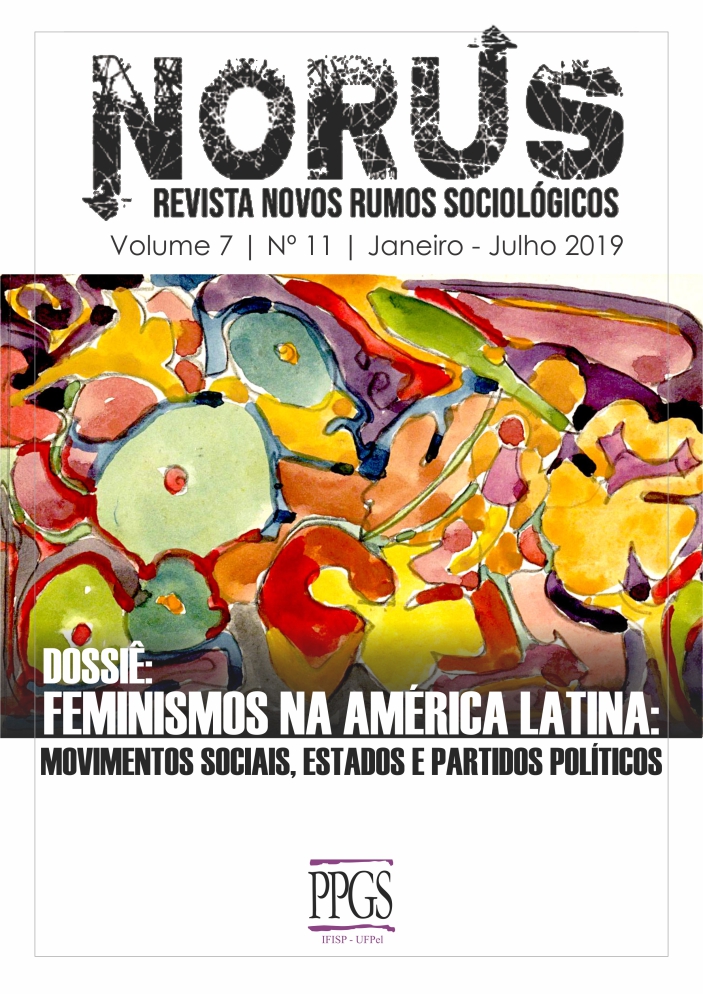A COBERTURA JORNALÍSTICA SOBRE O FEMINISMO BRASILEIRO (1921 A 2016): RELAÇÃO DE PÚBLICO E PRIVADO NA NARRATIVA SOBRE O ATIVISMO
Resumo
Este trabalho analisa a cobertura sobre o movimento feminista brasileiro no jornal Folha de São Paulo, entre os anos de 1921 a 2016, a partir de uma amostra com 579 textos, com o recorte temporal em três períodos distintos (1921-1959; 1960-1989; 1990-2016), a partir das ondas da historiografia feminista. Metodologicamente, empregamos a análise qualitativa de enquadramento, discutindo como a relação entre público versus privado, central na produção da teoria política feminista, pode colaborar para o entendimento de narrativas midiáticas sobre questões de gênero, em especial acerca do ativismo feminista. Os enquadramentos encontrados nos textos do periódico apontam, no primeiro período temporal, para um isolamento das atrizes feministas ao privado e também para processo de concessão masculina à entrada delas no público. No segundo momento, o enquadramento proeminente é da intersecção entre as duas esferas. No terceiro período temporal foram identificados enquadramentos de desnaturalização e re-naturalização acerca da relação entre as arenas.Referências
ALVAREZ, Sonia. Para além da sociedade civil: reflexões sobre o campo feminista. Cadernos Pagu, Campinas, n. 43, 2014, p. 13-56.
ANTUNES, Elton. Enquadramento: considerações em torno de perspectivas temporais para a notícia. Revista Galáxia, São Paulo, n. 18, 2009, p.85-99.
BARKER-PLUMMER, Bernadette. News and feminism: a historic dialog. Journalism & Communication Monographs, 12, 2010, p. 145–203
CARVALHO, Carlos Alberto. Sobre limites e possibilidades do conceito de enquadramento jornalístico. Contemporânea, Salvador, vol. 7, n 2, 2009, p. 1-15.
CHONG, Dennis; DRUCKMAN, James N. Framing theory. Annu. Rev. Polit. Sci., 10, 2007, p. 103–26.
COHEN, Jean. Repensando a privacidade: autonomia, identidade e a controvérsia sobre o aborto. RBCP, Brasília, n. 7, 2012, p. 165-203.
COLLINS, Patricia Hill. The Social Construction of Black Feminist Thought. In: _____. Black Feminist Thought: Knowledge, Consciousness, and the Politics of Empowerment. NY: Routledge, 2000, p. 1-44
ENTMAN, Robert. Framing: towards clarification of a fractured paradigm. Journal of Communication, v. 43, n. 4, 1993. p. 51-58,
GILLIGAN, Carol. Imagens de relação. In: MIGUEL, Luis Felipe; BIROLI, Flavia. Teoria política feminista: textos centrais. Vinhedo: Editora, 2013, p. 81-120.
GOFFMAN, Erving. Frame Analysis. An Essay on the Organization of Experience. Boston: Northeastern University Press, 1974.
HIGH-PIPPERT, Angela. A Million Moms, MADD Mothers, and Feminists: Media Coverage of Women Activists. In: CARILLI, Theresa; CAMPBELL, Jane (eds.). Women and media – diverse perspectives. University Press of American, 2005, p. 199-211.
hooks, bell. Homeplace: a site of resistance. In:______ . Yearning: race, gender, and cultural politics. South End Press: Boston, 1990, p. 41.50
LIND, Rebecca; SALO, Coleen. The framing of feminists and feminism in news and public affairs programs is U.S. electronic media. Journal of Communication, 2002, p. 211-228.
MENDES, Kaitlynn ‘Feminism rules! Now, where’s my swimsuit?’ Re-evaluating feminist discourse in print media 1968–2008. Media, Culture & Society. 34(5), 2012, p. 554–570.
MENDES, Kaitlynn. Framing Feminism: News Coverage of the Women’s Movement in British and American Newspapers, 1968–1982. Social Movement Studies, Vol. 10, No. 1, 2011a, p. 81-98.
MENDES, Kaitlynn. Reporting The Women's Movement. Feminist Media Studies, 11:4, 2011b, p. 483-498.
MENDES, Kaitlynn. Slutwalk, feminism and news. In: SILVA, K.; MENDES, K. Feminist erasures. Challenging Backlash Culture. Londres: Palgrave Macmillan, 2015, p. 219-234.
MENDONÇA, Ricardo Fabrino; SIMÕES, Paula. Enquadramento: Diferentes operacionalizações analíticas de um conceito. RBCS, Brasília, v. 27, n.79, 2012, p.117-235.
NORRIS, Pippa. Women Leaders Worldwide: A Splash of Color in the Photo Op. In: ______. (eds).Women, media, and politics. NY: Oxford Press, 1997, p. 149-165.
NORTH, Louise. Rejecting the ‘F-word’. How ‘feminism’ and ‘feminists’ are understood in the newsroom. Journalism. v.10 (6), 2009, p. 739-757.
OKIN, Susan. Justice, gender, and family. NY: Basic Books, 1989.
PATEMAN, Carol. O contrato sexual. Rio de Janeiro: Paz e Terra, 1993.
PINTO, Celi. Uma História do feminismo no Brasil. São Paulo: Fundação Perseu Abramo, 2003.
REESE, Stephen. The Framing Project: A Bridging Model for Media Research Revisited. Journal of Communication, v.57, n. 1, 2007, p. 148-154.
ROSS, Karen. Women, politics, media: uneasy relations in comparative perspectives. Hampton Press, 2002.a
SARMENTO, Rayza. Mídia, gênero e política: breve mapeamento de horizontes analíticos. Ação Midiática - Estudos em Comunicação, Sociedade e Cultura, Curitiba, v. 2, 2013, p. 1-15.
SARMENTO, Rayza. Das sufragistas às ativistas 2.0: feminismo, mídia e política no Brasil (1921a 2016). 2017. Tese de Doutorado. Universidade Federal de Minas Gerais, Belo Horizonte, 2017.
SARMENTO, Rayza Estudos feministas de mídia e política: uma visão geral. BIB, São Paulo, , v. 87, 2018. p. 181-202
SHERIDAN, Susan et.al. Feminism in the news. In: HOLLOWS, Joanne; MOSELEY, Rachel. Feminism in popular culture. NY: Berg Publishers, 2006, p. 25-40.
SNOW, David. BENFORD, Robert. Master frames and Cycles of Protest. In: Morris, Al. et al. Frontiers in Social Movement Theory. New Haven: Yale University Press, 1992, p. 133-155.
VAN GORP, Baldwin. The constructionist approach to framing: bringing culture back in. Journal of Communication, v. 57, n.1, 2007, p. 60-78
VAN ZOONEN, Liesbet. The women’s movement and the media: constructing a public identity. European Journal of Communication. v.7, 1992, p. 453-476.
WALBY, Silvia. Theorizing patriarchy. Oxford: Blackwell, 1990.
YOUNG, Iris Marion. Justice and the Politics of Difference. Princeton: Princeton University Press, 1990.
Copyright (c) 2019 Autor e Revista

This work is licensed under a Creative Commons Attribution-NonCommercial-NoDerivatives 4.0 International License.
Os Direitos Autorais para artigos publicados nesta revista são do(a) autor(a), com direitos de primeira publicação para a revista. Os artigos são de uso gratuito em aplicações exclusivamente acadêmicas e educacionais e, portanto, não-comerciais.


